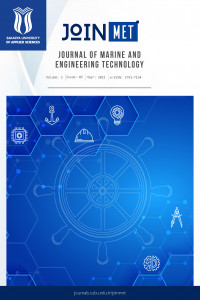Öz
This article is aimed to provide a comprehensive understanding about Computational Fluid Dynamics (CFD) analysis of a ship propeller and the validation of the results obtained in the analyses with those of open water tests. The open water tests of the propellers and their outputs are explained briefly. Alternative computational solutions and its importance are also emphasized. A propeller of the modified type of Wageningen B.4 was investigated to validate CFD results.It is also aimed to focus on cavitation phenomena of this propeller. Nature of cavitation is introduced and the aforesaid propeller is also investigated to visualize the starting and development phases of cavitation. The simulation results of both cavitating and non-cavitating flows are compared with the experimental data.
Anahtar Kelimeler
Kaynakça
- Arazgaldi, R., Hajilouy, A., & Farhanieh, B. (2009). Experimental and numerical investigation of marine Propeller cavitation. Mechanical Engineering, 16 (6), 525-533.
- Bertetta, D., Brizzolara, S., Gaggero, S., Viviani, M., & Savio, L. (2012). CPP propeller cavitation and noise optimization at different pitches with panel code and validation by cavitation tunnel measurements. Ocean Engineering, 53, 177 195.
- Chang, Y., Hu, C., Tu, J., & Chow, Y. (2010). Experimental investigation and numerical prediction of cavitation incurred on propeller surfaces. Journal of Hydrodynamics, 22 (5), 764-769.
- Da-Qing, L. (2006). Validation of RANS predictions of open water performance of ahighly skewed propeller with experiments. Journal of Hydrodynamics, 18 (3),520-528.
- Dubbioso, G., Muscari, R., & Di Mascio, A. (2013). Analysis of the performances of a marine propeller operating in oblique flow. Computers & Fluids, 75 (20), 86102.
- Kinnas, S. A., Lee, H., & Young, Y.L. (2003). Modeling of unsteady sheetcavitation on marine propeller blades. International Journal of Rotating Machinery, 9, 263-277.
- Martio, J., Sipila, T., Sanchez-Caja, A., Saisto, I. & Siikonen, Timo. (2011). Evaluation of the propeller hull vortex using a RANS solver. Second International Symposium on Marine Propulsors, Hamburg University of Technology, Hamburg, Germany, 15-17 June.
- Molland, A. F. (2011). The maritime engineering reference book: a guide to ship design, construction and operation. Oxford: Elsevier.
- Peng, H., Qiu, W., & Ni, S. (2013). Effect of turbulence models on RANS computation of propeller vortex flow. Ocean Engineering, 72, 304-317.
- Salvatore, F., Greco, L., & Calcagni, D. (2011). Computational analysis of marine propeller performance and cavitation by using an inviscid-flow BEM model.Second International Symposium on Marine Propulsors.
- Salvatore, F., Streckwall, H., & Terwisga, T. V. (2009). Propeller cavitation modelling by CFD-results from the VIRTUE 2008 Rome workshop. In Proceedings of the First International Symposium on Marine Propulsors.
- Zhang, Q., Zhang, X., Hu, D., & Liu, Y. (2011). Flow simulation in steering rotary valve. Electric Information and Control Engineering (ICEICE) International Conference, 2208-2212.
- Zhao, Y. (2015). Investigation in scale effects on propellers with different magnitude of skew by CFD methods. MSc Thesis, Ålesund University College, Ålesund.
Ayrıntılar
| Birincil Dil | Türkçe |
|---|---|
| Konular | Deniz Mühendisliği |
| Bölüm | Araştırma Makaleleri |
| Yazarlar | |
| Yayımlanma Tarihi | 31 Aralık 2021 |
| Gönderilme Tarihi | 22 Aralık 2021 |
| Yayımlandığı Sayı | Yıl 2021 Cilt: 1 Sayı: 2 |


